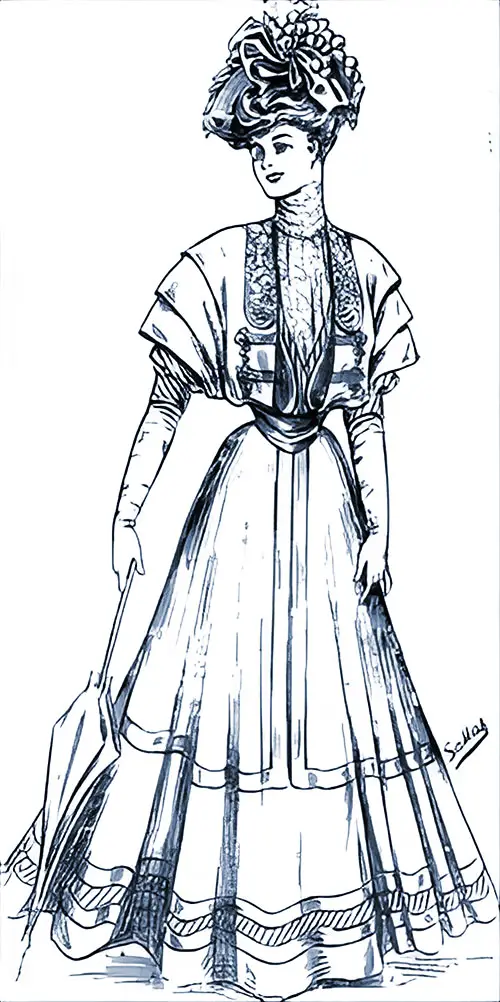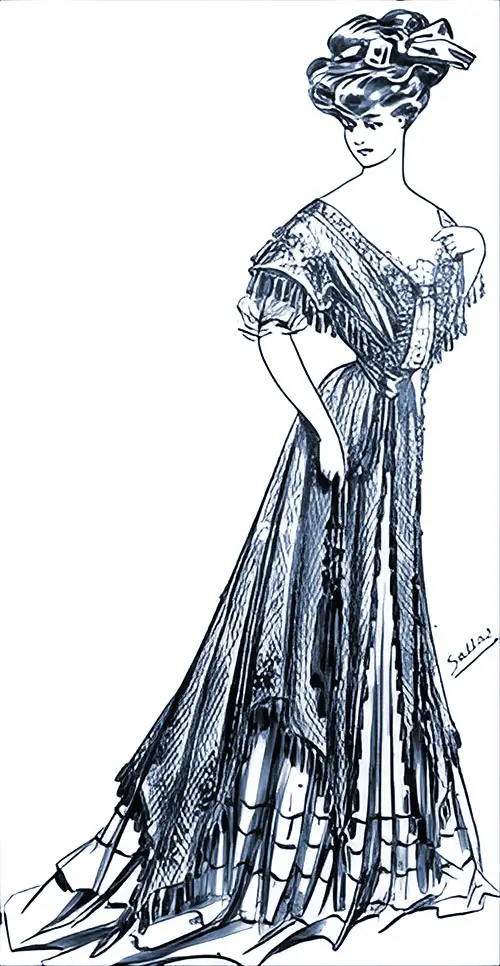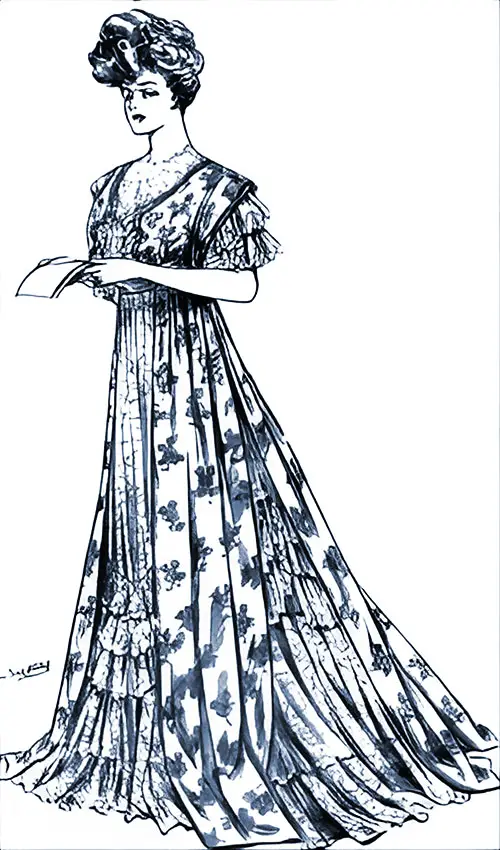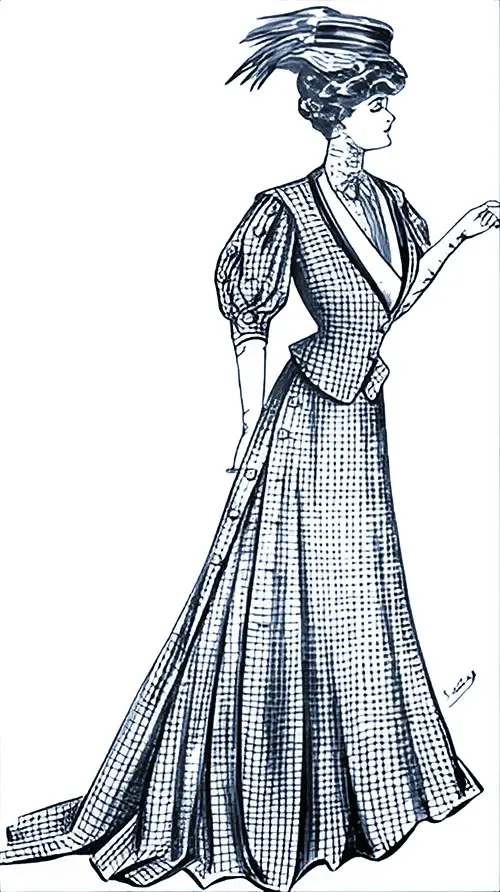World of Dress Fashions 1907
By Mrs. Eliza Aira
The World of Dress, an article by Mrs. Aria that appeared in the 1907 edition of the Cunard Daily Bulletin Fashion & Pleasure Resort Supplement provides an excellent review of the latest in Women's fine fashions at the turn of the twentieth century.
We meet in mid-ocean once again and sympathetically clasp hands, at least one hand, and that the left one, for my right is holding the pen which brings you the tidings of Fashion as she appears in London in the zenith of her early Springtime. On the whole, it must be conceded that her conduct is excellent.
Grace is her presiding ambition, and she is by no means regardless of the advantage of comfort. Her prominent desires seem modest too, for her skirts are long, the brims of her hats droop over the brows, there is a pensive hang on her sleeves, and she grants much concession to the individual in the selection of the position for her waistline.

Many of the new models are quite short-waisted in the back, with the lines placed a little lower down in the front, and special attention is being bestowed upon the arm-hole. This seems a somewhat unusual portion of attire to excite or merit attention, but the fact remains, arm-holes are primarily important.
Usually they are extremely wide, cut in one with a bodice which shows a tendency to drape from the shoulders and they bear some trimming of galon, or lace, or jet, or passementerie, to accentuate their effect.
A noticeable advantage of this method is that women with indifferent figures may look as well as those with good ones, since it has a tendency to suggest rather than to reveal, and to lend itself with conspicuous readiness to exploit the soft voiles which are our immediate delight.
About the trimming of these voiles, I regret that lace dyed to match has considerable vogue; coarse lace and fine lace being alike submitted to the machinations of the dyer, and permitted to do such duties which last season we accorded most freely to silken braid.
Not that braid is by any means disregarded, it appears under a variety of aspects adorning gowns of cloth and cashmere, but it shares favor with this colored lace, and personally I think it is a pity, holding always a brief for lace in white and lace in cream, while I would bestow only a moderate tolerance upon lace of tinsel.
This last, by the way, continues to receive patronage as a foundation for silken embroideries, or thickly worked with golden threads when it is allowed to form vests or yokes which extend their influence above the bloused bodice with the wide arm-holes and below a tight fitting inner vest of ivory-tinted lace.

But since a single drawing is worth an acre of description, I would best impress upon you the essential contour of La Mode's ambition, if I pray you look at these sketches.
At the walking dress in biscuit-colored cloth with guipure to form the collar, and stripes of black and white silk appearing between the straps on the skirt, and above the small waistcoat and below the under sleeves; cream lace extends from bust to neck and the hat is of biscuit-colored straw, trimmed with black glace ribbon and cherries.

In the evening dress (Sketch No. 2), do not fail to note the long shoulder again. This gown is made of pale yellow soft satin, covered with a drapery of coarse gold net, upon which a raised design of golden flowers disports itself, while golden tassels form the border, golden tissue encircles the waist, a bow of the same appearing in the hair.
You must observe the hair carefully, for in its shape you may notice that some considerable difference exists between it and the coiffure of yesteryear; outward set the waves, no longer upward, a subtle detail whose adoption will reveal to the eye of the expert the devotee of the latest.
The tea gown is of one of the new chink brocades, again with a wide arm-hole, bordered with a pale pink miroir velvet, and worn over a skirt of pale pink chiffon, draped with lace.
Chink silk with white grounds, patterned florally, or with our old friend the pine, are amongst the novelties, or at least, the revivals, it would be churlish to require a complete novelty, and it is really amazing, considering the reputation we women have somehow or other achieved for love of variety, the fidelity with which we cling to our old loves.
Take, for example, black and white check and blue serge, for Spring and for Autumn use, they are most firmly established for ever—and most desirable.
Just now the black and white checks share favor with the black and white stripes; either smooth of face or rough of face, either home-spun or in tweed, or in soft cloth; and indeed the combination of black and white appears to justify our perennial regard for it. The stripes are effectively used horizontally as trimming for a costume with the stripes perpendicular.

The coat and skirt— illustrated in No. 4—are of check, and the narrow collar is of velvet, the inner waistcoat of white cloth, while the buttons are covered with the check, and the shirt is of white cambric.
White wings extend their influence on one side of the hat, whose crown is encircled with a band of soft red silk, little frillings of brown tulle being arranged on the bandeau to rest on the hair. Brown tulle is ubiquitous in such relations.
Any alteration of the shape of the coiffure causes, of course, considerable alteration in the shape of the hats, and the distinguishing feature of the latest examples of millinery shows them with the brim much wider at the back than in the front, the feathers arranged to fall on the hair and the trimming confined to ribbons, low in the front, and in profusion behind.
Ribbons of all sorts put in an appearance, plain, patterned, glace, velvet and brocaded, the bordered ribbon is also in prominence and an easy means of bestowing distinction upon a simple hat of black is by trimming it with black velvet ribbon, edged with kilted tulle.
Very long ostrich feathers which conduct themselves round the neck in boa fashion, depend with some grace from open brimmed hats with small square crowns, but even more popular than this is the feather which hangs loosely to the shoulder, and the fountain feather is still in the scheme of modish millinery.
But yet with all these fancies for feathers, flowers are by no means disregarded, anemones of different colors being perhaps the latest, while geraniums of many colors, green ferns and brilliant roses, all blossom, merrily conscious of their persuasive charms.
Thinking the matter over, I am doubtful as to which I could truthfully describe as the most favored color: all shades of yellow, from the palest to deep orange were threatened, but buff and lemon tones alone receive extensive patronage.
Many dull shades of pink and purple and mulberry are in evidence and the lighter shades of hyacinth-blue and Wedgewood blue continue to enjoy some measure of attention.
Interviewing with some interest specimens of the latest petticoats, I have come to the conclusion that the most alluring is a glace foundation with a hand-embroidered lawn frill, headed with a beading threaded with ribbon and resting upon a glace flounce covered with a muslin flounce trimmed with lines of Valenciennes lace.
I have seen this model in white and also in black and white check, threaded with black ribbons, and I recognize that it would be a desirable possession in colors to match any hat or frock it accompanied.
The lawn flounce lends itself amiably even to an unsympathetic laundress, who may ensure that freshness without which no petticoat should be considered worthy of wear. Nothing looks worse than a tumbled or crumpled under-skirt, and the like, I regret to chronicle, it is my misfortune to. meet continually.
But to return for a moment to the crowning point of costume, I would mention emphatically that the outline of this season differs from the outline of last, when the hair was very straight in the front, slightly puffed over the ears and much curled on the top.
Now, the hair, whilst loosely waved, is brushed outward rather than upwards, is rather flat on the head, and the curls—those inevitable curls which have been indispensable now for some months—are pinned a little lower than the top of the crown, giving a great length of line straight back from the brow.
Most likely this is but a passing- fancy, but it has not yet passed. It has indeed but just arrived, and the decoration which is most after for its advantage is the osprey, set slantways, but aggressively.
Alas for the hopes of the Bird Protection Societies, not alone is the osprey flourishing in favor, but birds of ornithological specimens of every description decorate the heads and hats of fair and unfair woman.
Evening dress becomes more and more gorgeous, and the chine silks and brocades are allied with some skill and much elaboration to golden net and lace intersected with medallions of embroidery.
The ordinary spangle has resigned its first place in favor of the bugle of our grandmothers' delight, a position which is being disputed by an iridescent rough-surfaced paillette, quite the latest thing in gee-gaw trimming.
Bugles, as a matter of fact, are far less easy to handle than paillettes, and I would declare that the fight will end in favor of the latter even while remembering with considerable gratitude a beautiful dress made in the Princess' style of miroir grey velvet, with a décolletage cut square and outlined with a square collar of white net traced with diamonds and crystal bugles, an inner chemisette of tulle being treated in the same way.
Whilst the short tight sleeve-were of tulle banded with the crystals and diamonds and on the head of the wearer of this was fixed a diamond bird to hold the stem of white osprey which stretched backward to about the length of six inches.
The cloak which completed this was of pearl-grey cloth, trimmed with heavy gold embroidery and golden tassels and a narrow border of mink tail; a garment of luxury, and perhaps on the word luxury I may most justly finish my attempt to act as intermediary between you, my dear American cousins, and the London fashions of 1907.
From the fashions of the Metropolis to climes where such are possibly more in keeping with climatic conditions than here is a natural transition. Lucerne is not in these days of quick travel far removed from London, and there the Caravansary par excellence is Hotel d'Europe quiet, secluded and comfortable, situated among charming surroundings. Switzerland is, however, only one of Europe's playgrounds.
Their number and attractiveness increases each year, and those desirous of ascertaining just where to go and how to get there cannot do better than consult the organizers of the Polytechnic Tours.
Davis, Eliza (Mrs. Aria), "The World of Dress," in The Cunard Daily Bulletin: Fashion & Pleasure Resort Supplement, Liverpool: Cunard Line Steam Ship Co. Ltd., 1906.
